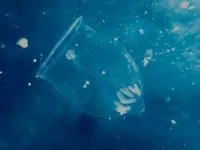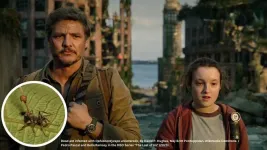(Press-News.org) In the dark and cold of the months-long polar night, food resources are limited. Some groups of marine organisms in the polar regions overcome this challenge by going into a metabolic resting state in winter, surviving on reserves accumulated during the short growth season. But others, such as several species of marine zooplankton, have evolved a different strategy: they shift from a specialized to an omnivorous diet during the polar night, profiting from a wide range of potentially less rewarding foods that are available throughout the year.
Now, scientists have shown that one key source of food for such seasonal Arctic omnivores has been overlooked until now: dead and living jellyfish. The results are published in Frontiers in Marine Science.
“Here we show for the first time that jellyfish – thought to be typically poor in nutrients – are nevertheless an important food source for amphipods during the Arctic polar night,” said Annkathrin Dischereit, a doctoral student at the Alfred Wegener Institute in Germany, and the article’s first author.
“For example, we found evidence that some amphipods feast on ‘jelly-falls’, naturally sunken jellyfish carcasses. Other species may also prey on living jellyfish.”
In January and February 2022, Dischereit and others from the Helmholtz Young Investigator Group ARJEL at the Alfred Wegener Institute took part in an expedition to the German-French AWIPEV research station on Svalbard.
Venturing out in a small boat from Kongsfjorden, Svalbard, the researchers found its waters to be teeming with jellyfish: not just ‘true jellyfish’ like the lion's mane jellyfish, but also hydrozoans like the thimble-shaped pink helmet jellyfish, colonial siphonophores, and unrelated comb jellies or ctenophores.
The researchers sampled the local amphipods – crustaceans between five and 20 millimeters long – with nets and baited traps. They had chosen to focus on amphipods because they are locally abundant and important components of the fjord systems. The catch mainly consisted of four species: Orchomenella minuta and Anonyx sarsi, scavenging amphipods in the superfamily Lysianassoidea, and two distantly related Gammarus species.
DNA metabarcoding of ingested prey
The researchers dissected the guts out of each amphipod, and then used DNA metabarcoding to identify the remains of prey within.
Jellyfish DNA from multiple species predominated in the guts of both Gammarus species, together with traces from algae and crustaceans. Jellyfish DNA was likewise found, but less abundant, in A. sarsi and O. minuta, proving that all four species studied routinely consume jellyfish tissue. The authors conclude that A. sarsi and O. minuta seem to opportunistically feed on jelly-falls, while both Gammarus may in addition prey on live comb jellies.
Fish – living or dead – were likewise important food for both A. sarsi and O. minuta, together with polychaete worms, crustaceans, and mollusks.
Dischereit et al. also found that between 27% and 60% of the sampled amphipods had empty guts. This confirms that food scarcity and starvation are a challenge to marine invertebrates during the polar night, even for species that can shift to a more omnivorous diet.
Paradigm shift on jellyfish
“There has been a recent paradigm shift in the marine biology literature that recognizes that far from being a ‘trophic dead-end’, jellyfish are in fact eaten by a wide range of organisms. Our observations corroborate this major change in how scientists view the role of jellyfish in the food web,” said Dr Charlotte Havermans, the leader of the 2022 expedition and the study’s last author.
“Because jellyfish tissue is quickly digested, they may have been overlooked as a prey item in previous studies, which unlike our study relied on visual identification of food items to determine the diet of Arctic invertebrates.”
‘Atlantification’ and the new Arctic
Today, the Arctic is warming at a record rate compared to the rest of the world, and jellyfish species from the Atlantic Ocean have been observed to spread northward. This ‘Atlantification’ may make jellyfish even more important as a resource within Arctic food webs.
“To get a better idea of the role of jellyfish in the Arctic marine food web, and how this may change when their populations increase in the ‘new Arctic’, we plan to further investigate the diet of other invertebrates and fish that potentially feed on jellyfish. Questions remain, for example, whether jellyfish are a regular part of the diet of amphipods or whether they are simply a survival food during the polar night”, concluded Dischereit.
END
Tiny crustaceans discovered preying on live jellyfish during harsh Arctic night
First observation of marine invertebrates eating live and dead jellyfish during Arctic winter
2024-02-14
ELSE PRESS RELEASES FROM THIS DATE:
It's award season: let's celebrate microbes in movies
2024-02-14
Elche (Spain), January 22, 2024. Usually, show business depicts viruses, bacteria, and other microorganisms as one of the worst menaces to humankind. Entertainment movies influence the way audiences understand and perceive these topics. Yet, few films accurately portray the science of microbiology and its social implications. Movies and TV series often feature outbreaks of deadly diseases and the efforts of scientists and medical professionals to contain them. However, entertainment movies can also educate the public about the importance and the impact ...
New treatment developed to dramatically slow down the progression of blindness-causing retinal diseases
2024-02-14
The Korea Institute of Science and Technology (KIST) announced that Dr. Maesoon Im of the Brain Science Institute, together with Prof. Seung Ja Oh of Kyung Hee University and Prof. Kangwon Lee of Seoul National University, successfully incorporated anti-inflammatory drugs into a hydrogel to suppress inflammation in the retina and effectively deliver the drugs to the inflamed area.
Age-related macular degeneration and retinitis pigmentosa are incurable eye diseases that cause blindness due to the gradual damage of photoreceptor cells, which convert light into biological signals in the retina, the light-sensitive tissue at the back of the eye. Age-related macular degeneration is a condition ...
Menopause and migraines: New findings point to power of prevention
2024-02-14
For middle-aged women plagued by migraines, or hot flashes and night sweats, another worry may linger in the backs of their minds: whether these experiences have set them up for a heart attack, a stroke or another cardiovascular crisis.
After all, past research suggesting such a link during and after menopause has gotten a lot of attention.
But a pair of new studies in the journal Menopause suggest that most of them don’t need to worry as much, especially if they don’t have both migraines and long-term hot flashes and night sweats.
Instead, they should focus on tackling the ...
The combination of migraine and persistent hot flashes could prove deadly
2024-02-14
CLEVELAND, Ohio (Feb 14, 2024)—Hot flashes and migraine (particularly with aura) have been shown to be individual risk factors for cardiovascular disease because of associated poorer heart disease riskfactor profiles. A new study, however, is the first to examine the joint influences of migraine and hot flashes/night sweats (vasomotor symptoms) independent of traditional heart disease risk factors and estrogen use. Research results are published online today in Menopause, the journal of The Menopause Society.
Specifically, ...
Acupuncture may curb heightened risk of stroke associated with rheumatoid arthritis
2024-02-14
A course of acupuncture may curb the heightened risk of stroke associated with rheumatoid arthritis, finds a comparative study published in the open access journal BMJ Open.
The effects seem to be independent of sex, age, medication use, and co-existing conditions, the findings indicate, prompting the researchers to suggest that the procedure may reduce levels of pro-inflammatory proteins (cytokines) in the body that are linked to cardiovascular disease.
The principal cause of death in people with rheumatoid arthritis is cardiovascular disease. And they are more likely to have a stroke than ...
Poor quality clinical data informing NICE decisions on treatments in over half of cases
2024-02-14
The quality of evidence submitted to the National Institute for Health and Care Excellence (NICE) for informing its decisions to recommend technologies for use in the NHS was poor in more than half of cases, reveals a 20-year analysis, published in the open access journal BMJ Open.
And the data quality submitted for health technology appraisals by manufacturers between 2000 and 2019 was consistently poor, with no improvement during that time, the analysis shows.
NICE advises the NHS on the ...
Age when periods first start and early menopause linked to heightened COPD risk
2024-02-14
A range of reproductive factors, including age when periods first start and an early menopause, are all linked to a heightened risk of COPD—the umbrella term for progressive lung conditions that cause breathing difficulties—finds research published online in the journal Thorax.
Miscarriage, stillbirth, infertility, and having 3 or more children are also associated with a heightened risk of COPD, which includes emphysema and chronic bronchitis, the findings show.
Recent evidence indicates substantial gender differences in susceptibility ...
Hostile environment policies linked to prolonged distress in people with Black Caribbean ancestry
2024-02-14
Psychological distress increased among people with Black Caribbean heritage in the UK, relative to the White population, following the 2014 Immigration Act and the Windrush scandal, finds a new study led by UCL researchers.
The researchers say their findings, published in The Lancet Psychiatry, suggest a causal link between government policies and a subsequent decline in mental health.
They were investigating the impact of the Immigration Act 2014, requiring landlords, employers, the NHS, banks and the police to check right-to-stay documentation. This was a key part of a set of measures known as the Home Office hostile environment policy, seeking ...
Clinical trial shows rheumatoid arthritis drug could prevent disease
2024-02-14
A drug used to treat rheumatoid arthritis could also prevent the disease in individuals deemed to be at risk.
Results from a Phase 2b clinical trial, published today in The Lancet by researchers led by King’s College London, provides hope for arthritis sufferers after it was shown that the biologic drug abatacept reduces progression to this agonising chronic inflammatory disease.
Rheumatoid arthritis affects half a million people in the UK and develops when the body’s immune system attacks itself, causing joint pain, swelling and significant disability. The disease most commonly begins in middle age, but much younger age groups can be afflicted, and until ...
Do apes have humor?
2024-02-14
Babies playfully tease others as young as eight months of age. Since language is not required for this behavior, similar kinds of playful teasing might be present in non-human animals. Now cognitive biologists and primatologists from the University of California Los Angeles (UCLA, US), the Max Planck Institute of Animal Behavior (MPI-AB, Germany), Indiana University (IU, US), and the University of California San Diego (UCSD, US) have documented playful teasing in four species of great apes. Like joking behavior in humans, ape teasing is provocative, persistent, and includes elements of surprise and play. Because all four great ape species used playful teasing, it is likely that the ...
LAST 30 PRESS RELEASES:
Longest observation of an active solar region
Why nail-biting, procrastination and other self-sabotaging behaviors are rooted in survival instincts
Regional variations in mechanical properties of porcine leptomeninges
Artificial empathy in therapy and healthcare: advancements in interpersonal interaction technologies
Why some brains switch gears more efficiently than others
UVA’s Jundong Li wins ICDM’S 2025 Tao Li Award for data mining, machine learning
UVA’s low-power, high-performance computer power player Mircea Stan earns National Academy of Inventors fellowship
Not playing by the rules: USU researcher explores filamentous algae dynamics in rivers
Do our body clocks influence our risk of dementia?
Anthropologists offer new evidence of bipedalism in long-debated fossil discovery
Safer receipt paper from wood
Dosage-sensitive genes suggest no whole-genome duplications in ancestral angiosperm
First ancient human herpesvirus genomes document their deep history with humans
Why Some Bacteria Survive Antibiotics and How to Stop Them - New study reveals that bacteria can survive antibiotic treatment through two fundamentally different “shutdown modes”
UCLA study links scar healing to dangerous placenta condition
CHANGE-seq-BE finds off-target changes in the genome from base editors
The Journal of Nuclear Medicine Ahead-of-Print Tip Sheet: January 2, 2026
Delayed or absent first dose of measles, mumps, and rubella vaccination
Trends in US preterm birth rates by household income and race and ethnicity
Study identifies potential biomarker linked to progression and brain inflammation in multiple sclerosis
Many mothers in Norway do not show up for postnatal check-ups
Researchers want to find out why quick clay is so unstable
Superradiant spins show teamwork at the quantum scale
Cleveland Clinic Research links tumor bacteria to immunotherapy resistance in head and neck cancer
First Editorial of 2026: Resisting AI slop
Joint ground- and space-based observations reveal Saturn-mass rogue planet
Inheritable genetic variant offers protection against blood cancer risk and progression
Pigs settled Pacific islands alongside early human voyagers
A Coral reef’s daily pulse reshapes microbes in surrounding waters
EAST Tokamak experiments exceed plasma density limit, offering new approach to fusion ignition
[Press-News.org] Tiny crustaceans discovered preying on live jellyfish during harsh Arctic nightFirst observation of marine invertebrates eating live and dead jellyfish during Arctic winter





